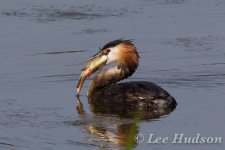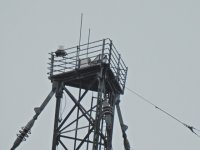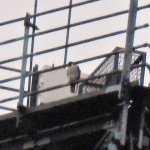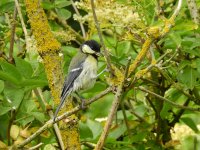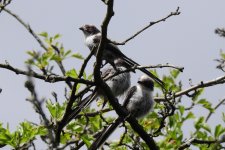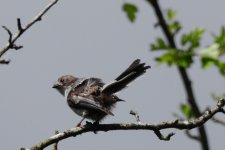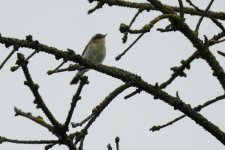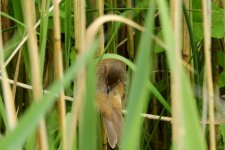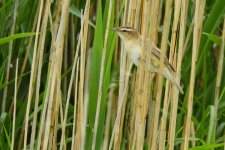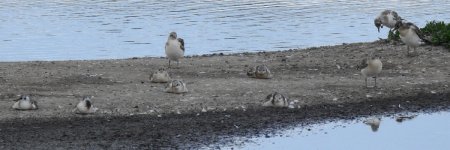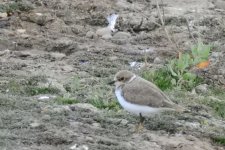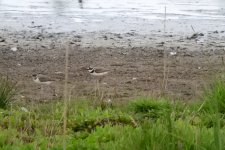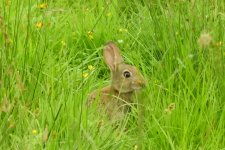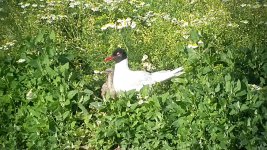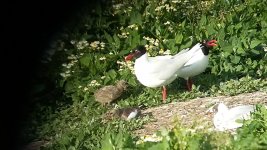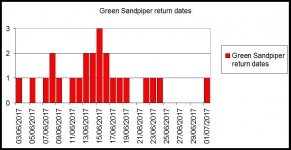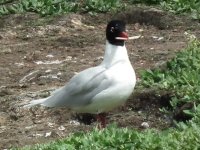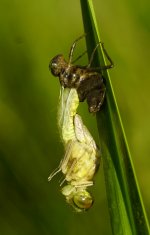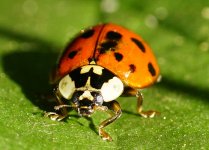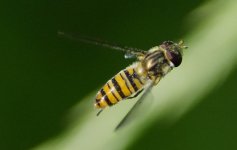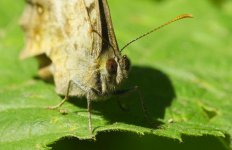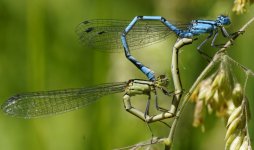-
Welcome to BirdForum, the internet's largest birding community with thousands of members from all over the world. The forums are dedicated to wild birds, birding, binoculars and equipment and all that goes with it.
Please register for an account to take part in the discussions in the forum, post your pictures in the gallery and more.
You are using an out of date browser. It may not display this or other websites correctly.
You should upgrade or use an alternative browser.
You should upgrade or use an alternative browser.
Upton Warren (124 Viewers)
- Thread starter andythomas
- Start date
More options
Who Replied?UW82
Well-known member
Today highlights on a very quiet day:
FLASHES/SAILING POOL*
LRP (4)---------------------Avocet (min 45) + 19 chicks
Lapwing (12)---------------Oystercatcher (2)
Shoveler (m)---------------Med Gull (1 ad)
Shelduck (1)---------------G C Grebe (2)*
Common Tern (2)*--------Cetti's Warbler*
Egyptian Goose*-----------Common Whitethroat (1)
MOORS/N MOORS*
Oystercatcher (3)----------Lapwing (2) + 3 chicks
Gadwall (2) + 4 chicks----Common Tern (5) + 1 chick
G C Grebe (1)--------------Little Grebe (3)
Med Gull ( 1x3 cal year)---Shoveler (m). The female and brood were not seen.
Common Whitethroat (1)*
Des.
FLASHES/SAILING POOL*
LRP (4)---------------------Avocet (min 45) + 19 chicks
Lapwing (12)---------------Oystercatcher (2)
Shoveler (m)---------------Med Gull (1 ad)
Shelduck (1)---------------G C Grebe (2)*
Common Tern (2)*--------Cetti's Warbler*
Egyptian Goose*-----------Common Whitethroat (1)
MOORS/N MOORS*
Oystercatcher (3)----------Lapwing (2) + 3 chicks
Gadwall (2) + 4 chicks----Common Tern (5) + 1 chick
G C Grebe (1)--------------Little Grebe (3)
Med Gull ( 1x3 cal year)---Shoveler (m). The female and brood were not seen.
Common Whitethroat (1)*
Des.
Phil Andrews
It's only Rock and Roller but I like it

From the Flashes yesterday evening Mike W reports now only 17 Avocet young. Also a ringed first summer Black-headed Gull - black ring with white 2BKV, a bird from Marsh Lane.
Phil Andrews
It's only Rock and Roller but I like it

In what is a traditionally quiet time of year, June's list has crawled to 71 species at the month's midpoint. Potential additions for the remainder of June include:
Little Egret, Cormorant, Water Rail, Hobby, Pheasant, Dunlin, Ruff, Green Sandpiper, Common Sandpiper, Snipe, Black-tailed Godwit, Common Gull, Little Gull, Yellow-legged Gull, Cuckoo, Green Woodpecker, Sand Martin, Yellow Wagtail, Redstart, Mistle Thrush, Garden Warbler, Lesser Whitethroat, Goldcrest, Coal Tit, Spotted Flycatcher, Treecreeper, Nuthatch, Rook
Little Egret, Cormorant, Water Rail, Hobby, Pheasant, Dunlin, Ruff, Green Sandpiper, Common Sandpiper, Snipe, Black-tailed Godwit, Common Gull, Little Gull, Yellow-legged Gull, Cuckoo, Green Woodpecker, Sand Martin, Yellow Wagtail, Redstart, Mistle Thrush, Garden Warbler, Lesser Whitethroat, Goldcrest, Coal Tit, Spotted Flycatcher, Treecreeper, Nuthatch, Rook
wheatearlp
Well-known member

Had three Sand Martins over Moors yesterday evening
lickey1
Well-known member
Photo's from Thursday
Attachments
-
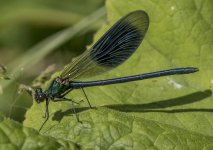 A Banded demoiselle - Calopteryx - splendens 2J4A8208.jpg170.1 KB · Views: 33
A Banded demoiselle - Calopteryx - splendens 2J4A8208.jpg170.1 KB · Views: 33 -
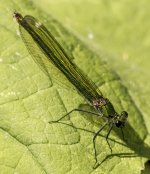 A Banded demoiselle - Calopteryx - splendens 2J4A8227.jpg352.5 KB · Views: 26
A Banded demoiselle - Calopteryx - splendens 2J4A8227.jpg352.5 KB · Views: 26 -
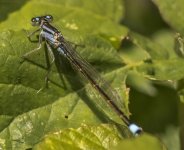 A Blue-tailed damselfly - Ischnura elegans 2J4A8203.jpg255.5 KB · Views: 30
A Blue-tailed damselfly - Ischnura elegans 2J4A8203.jpg255.5 KB · Views: 30 -
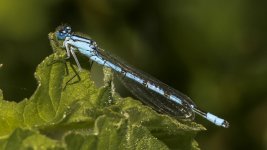 A Common blue damselfly - Enallagma cyathigerum (Male) 2J4A8297.jpg132.4 KB · Views: 29
A Common blue damselfly - Enallagma cyathigerum (Male) 2J4A8297.jpg132.4 KB · Views: 29 -
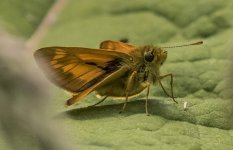 A Large skipper - Ochlodes venata 2J4A8272.jpg214.7 KB · Views: 32
A Large skipper - Ochlodes venata 2J4A8272.jpg214.7 KB · Views: 32
Where Bird
Well-known member
Janner Falcon!
Well-known member
Janner Falcon!
Well-known member
Janner Falcon!
Well-known member
Flashes continued:
1. Last time it was penguins - now a seal colony (cold wind last time - hot today!)
2. Young LRP - very yellow lower legs
3. Training for LRP Olympics. This young LRP was chased up and down this short piece of shore by an adult for over 10 minutes. I'm not convinced this is the same youngster - apparently stronger collar pattern and darker legs
4. continuing the 'baby' theme!
1. Last time it was penguins - now a seal colony (cold wind last time - hot today!)
2. Young LRP - very yellow lower legs
3. Training for LRP Olympics. This young LRP was chased up and down this short piece of shore by an adult for over 10 minutes. I'm not convinced this is the same youngster - apparently stronger collar pattern and darker legs
4. continuing the 'baby' theme!
Attachments
Phil Andrews
It's only Rock and Roller but I like it

From yesterday evening at the reserve JTB reports:
MOORS POOL
Med Gull with young, 4 Oystercatcher + 2 young, 8 Common Tern with 4 young (2+1), male Teal, Gadwall with brood of 4
FLASHES
Shoveler, 2 Shelduck, 4 adult LR Plover and 1 juv raised elsewhere, 20 Lapwing, 1 Oystercatcher, 47 adult Avocet and 21 young from 11 broods (new family with 2 young from the sewage meadow, 3 Med Gulls
SAILING POOL
Lesser Whitethroat
However the most important news from yesterday is that we can now reveal that in addition to the pair that have hatched two young at the Moors Pool, a pair of Mediterranean Gulls have also been nesting at the Flashes with one young noted in very deep cover yesterday :t:
MOORS POOL
Med Gull with young, 4 Oystercatcher + 2 young, 8 Common Tern with 4 young (2+1), male Teal, Gadwall with brood of 4
FLASHES
Shoveler, 2 Shelduck, 4 adult LR Plover and 1 juv raised elsewhere, 20 Lapwing, 1 Oystercatcher, 47 adult Avocet and 21 young from 11 broods (new family with 2 young from the sewage meadow, 3 Med Gulls
SAILING POOL
Lesser Whitethroat
However the most important news from yesterday is that we can now reveal that in addition to the pair that have hatched two young at the Moors Pool, a pair of Mediterranean Gulls have also been nesting at the Flashes with one young noted in very deep cover yesterday :t:
Attachments
Last edited:
Phil Andrews
It's only Rock and Roller but I like it

As promised earlier in the month, here is the history of some of the more infrequent breeding wildfowl that have nested at Upton Warren this year:
Greylag Goose
1991 - one paired with a Canada Goose but no offspring was forthcoming
1992 - one paired with a Canada Goose, producing one hybrid gosling
2007 - a pair nested on the reserve, producing one gosling from the 17th May which was subsequently killed by an aggressive Mute Swan twelve days later
2008 - a pair bred at the Moors Pool with five young from the 9th May but none noted in June
2009 - a pair nested at the Sailing Pool with eight young from the 2nd May of which all but one proceeded to fledge
2015 - a pair bred at the Moors Pool, hatching four young from the 7th May which then relocated to the Sailing Pool where they all fledged
2016 - one pair bred at the Moors Pool with two goslings there on the 3rd May but not noted again
2017 - a pair bred at the Sailing Pool with five young noted on the 6th June, reduced to three goslings by the following day
Shoveler
1947 - one pair bred, producing eight young from the 1st July
2013 - one pair unsuccessfully nested at the Flashes
2014 - one pair bred at the Moors Pool with ten ducklings noted in Amy's Marsh on the 12th June, all of which successfully survived to fledge
2015 - two pairs bred on the reserve. A pair nested at the Flashes with ten young emerging on the third Flash on the 25th May; all had succumbed by the 10th June due to attentions of Buzzards and Herons. A pair also bred at the Moors Pool with a brood of eight noted from the 22nd June of which six fledged
2016 - assumedly two pairs bred at the Flashes; a brood of 12 ducklings was seen on the 21st May which had expanded to 21 young three days later. The combined brood was reduced to 13 by the 25th June, all of which then fledged
2017 - one pair bred at the Moors Pool with seven young observed on the 13th June
Gadwall
1988 - a pair bred on the North Moors, producing four young from the 25th June; all four fledged but one perished shortly after.
2008 - a pair bred at the Flashes with ten ducklings seen on the 13th June. Numbers were reduced to ten by the end of the month but all are believed to have fledged
2011 - there was an unconfirmed report of a brood of four at the Moors Pool in mid May
2013 - a pair bred at the Moors Pool with seven young present from the 22nd June, all of which successfully fledged
2015 - one pair bred at the Moors Pool with eight young emerging on the 30th May of which five proceeded to fledge
2016 - two pairs bred at the Moors Pool. Six young were noted from the 5th June which gradually reduced to just one by the 10th July. The second pair emerged unseen with two well developed ducklings seen on the 19th July and several days thereafter
2017 - one pair bred at the Moors Pool with seven duckling there from the 28th May which was reduced to four birds
Greylag Goose
1991 - one paired with a Canada Goose but no offspring was forthcoming
1992 - one paired with a Canada Goose, producing one hybrid gosling
2007 - a pair nested on the reserve, producing one gosling from the 17th May which was subsequently killed by an aggressive Mute Swan twelve days later
2008 - a pair bred at the Moors Pool with five young from the 9th May but none noted in June
2009 - a pair nested at the Sailing Pool with eight young from the 2nd May of which all but one proceeded to fledge
2015 - a pair bred at the Moors Pool, hatching four young from the 7th May which then relocated to the Sailing Pool where they all fledged
2016 - one pair bred at the Moors Pool with two goslings there on the 3rd May but not noted again
2017 - a pair bred at the Sailing Pool with five young noted on the 6th June, reduced to three goslings by the following day
Shoveler
1947 - one pair bred, producing eight young from the 1st July
2013 - one pair unsuccessfully nested at the Flashes
2014 - one pair bred at the Moors Pool with ten ducklings noted in Amy's Marsh on the 12th June, all of which successfully survived to fledge
2015 - two pairs bred on the reserve. A pair nested at the Flashes with ten young emerging on the third Flash on the 25th May; all had succumbed by the 10th June due to attentions of Buzzards and Herons. A pair also bred at the Moors Pool with a brood of eight noted from the 22nd June of which six fledged
2016 - assumedly two pairs bred at the Flashes; a brood of 12 ducklings was seen on the 21st May which had expanded to 21 young three days later. The combined brood was reduced to 13 by the 25th June, all of which then fledged
2017 - one pair bred at the Moors Pool with seven young observed on the 13th June
Gadwall
1988 - a pair bred on the North Moors, producing four young from the 25th June; all four fledged but one perished shortly after.
2008 - a pair bred at the Flashes with ten ducklings seen on the 13th June. Numbers were reduced to ten by the end of the month but all are believed to have fledged
2011 - there was an unconfirmed report of a brood of four at the Moors Pool in mid May
2013 - a pair bred at the Moors Pool with seven young present from the 22nd June, all of which successfully fledged
2015 - one pair bred at the Moors Pool with eight young emerging on the 30th May of which five proceeded to fledge
2016 - two pairs bred at the Moors Pool. Six young were noted from the 5th June which gradually reduced to just one by the 10th July. The second pair emerged unseen with two well developed ducklings seen on the 19th July and several days thereafter
2017 - one pair bred at the Moors Pool with seven duckling there from the 28th May which was reduced to four birds
Phil Andrews
It's only Rock and Roller but I like it

We are now entering the optimum time frame for the first returning Green Sandpipers at the Flashes - normally initially failed breeders followed by breeding adults and juveniles. The below graphic sets out the range of return dates where we have the information; unfortunately the data set is too limited to plot the same for Common Sandpiper with birds often lingering from the Spring making it difficult to determine what are recent migrants. This period of the year has proved productive in recent times for Spotted Sandpiper on inland sites caught up in the Common Sand movement so keep your eyes open!
Attachments
Dick-E-Dipper
Well-known member
midlands birder
Well-known member
A very bright and hot visit to both sides of the reserve this evening. Many birds hunkered down behind vegetation making counting difficult.
Moors
Viewing from the west track, both Mediterranean Gull chicks looked be be developing well. Both looked very advanced now, fully feathered and should be flying in the next few days. Only the 1 2nd summer bird on view.
3 House Sparrow were again around the feeders on the west side, including a very attractive male. Presumably the same birds as last weekend.
12 Gadwall were feeding on the pool, with a female with 4 fairly young chicks swimming into the broadmeadow channel. A single Shoveler.
Lots of Warbler activity, with around 8 Sedge Warbler between the bench and the hide, plus 3 near the Bittern channel. 3 Grey Heron, 2 Shelduck and Kingfisher among the usuals.
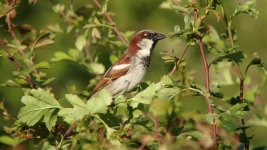
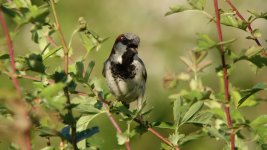
Flashes
The single Med Gull chick showing well on its nest island. Both parents visiting frequently, swapping duties. 2 Grey Heron here also, plus my first 2 Curlew in a while, 44 Lapwing, 4 LRP. Avocet numbers similar to recently. White ringed BHG this evening '28D1'. Also Painted Lady along the south shore of the sailing pool.
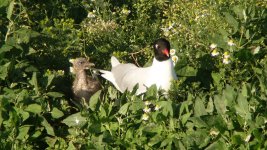
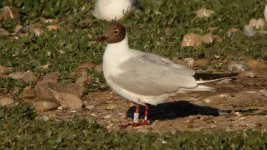
Moors
Viewing from the west track, both Mediterranean Gull chicks looked be be developing well. Both looked very advanced now, fully feathered and should be flying in the next few days. Only the 1 2nd summer bird on view.
3 House Sparrow were again around the feeders on the west side, including a very attractive male. Presumably the same birds as last weekend.
12 Gadwall were feeding on the pool, with a female with 4 fairly young chicks swimming into the broadmeadow channel. A single Shoveler.
Lots of Warbler activity, with around 8 Sedge Warbler between the bench and the hide, plus 3 near the Bittern channel. 3 Grey Heron, 2 Shelduck and Kingfisher among the usuals.


Flashes
The single Med Gull chick showing well on its nest island. Both parents visiting frequently, swapping duties. 2 Grey Heron here also, plus my first 2 Curlew in a while, 44 Lapwing, 4 LRP. Avocet numbers similar to recently. White ringed BHG this evening '28D1'. Also Painted Lady along the south shore of the sailing pool.


Phil Andrews
It's only Rock and Roller but I like it

Flashes
The single Med Gull chick showing well on its nest island. Both parents visiting frequently, swapping duties. 2 Grey Heron here also, plus my first 2 Curlew in a while, 44 Lapwing, 4 LRP. Avocet numbers similar to recently. White ringed BHG this evening '28D1'. Also Painted Lady along the south shore of the sailing pool.
The adult with white “28D1” is now been recorded for its five consecutive year, making it the most recorded gull at Upton Warren. It was ringed in the nest at Hosehill Lakes, Berkshire on the 4th June 2011. As far as I am aware other than its nest site and this reserve the bird has only been noted in one other location, the River Lee in Cork on the 1st January 2012; I will ask scheme coordinator (Tim Ball) for an updated history of this bird.
Phil Andrews
It's only Rock and Roller but I like it

This morning at the Flashes Dave J reports:
45 adult Avocet and 22 young (3:2:1:2:1:2:2:3:2:1:3), 3 adult Mediterranean Gull and 1 young, 4 LR Plover, 1 Teal
Egyptian Goose still on the Sailing Pool
45 adult Avocet and 22 young (3:2:1:2:1:2:2:3:2:1:3), 3 adult Mediterranean Gull and 1 young, 4 LR Plover, 1 Teal
Egyptian Goose still on the Sailing Pool
wheatearlp
Well-known member

Phil - has the the BHG I zaw on Thursday evening been recorded previously at Upton? Black darvic with white lettering 2BKV.
Birder Gladys
Well-known member
As promised earlier in the month, here is the history of some of the more infrequent breeding wildfowl that have nested at Upton Warren this year:
Greylag Goose
1991 - one paired with a Canada Goose but no offspring was forthcoming
1992 - one paired with a Canada Goose, producing one hybrid gosling
2007 - a pair nested on the reserve, producing one gosling from the 17th May which was subsequently killed by an aggressive Mute Swan twelve days later
2008 - a pair bred at the Moors Pool with five young from the 9th May but none noted in June
2009 - a pair nested at the Sailing Pool with eight young from the 2nd May of which all but one proceeded to fledge
2015 - a pair bred at the Moors Pool, hatching four young from the 7th May which then relocated to the Sailing Pool where they all fledged
2016 - one pair bred at the Moors Pool with two goslings there on the 3rd May but not noted again
2017 - a pair bred at the Sailing Pool with five young noted on the 6th June, reduced to three goslings by the following day
Great info Phil, when Mary(who finished school Friday) and I first came down to Upton Lapwing breeding was not happening now with the low grass in the meadow they been quite successful. Do you think Uptons success has be its own downfall too this year?
Similar threads
- Replies
- 1
- Views
- 1K
Users who are viewing this thread
Total: 125 (members: 6, guests: 119)




